
Charles "Pinky" Rohm, III: Builder, Designer, Conservationist/Innovator
During my recent visit to New Orleans I felt honored that classmate Pinky Rohm invited me to visit his uptown home on a leisurely Sunday afternoon to view the furniture and jewelry he designs and makes, to tour his workshop, and to talk about his lifetime creativity. I also had the privilege of meeting his wife Lindsey. While he has had two additional careers, in oil and gas and in construction, his real joy is in making things with his hands. In fact, he not only likes to make things with his hands, I would say that he also perceives, or "sees," with his hands.
He uses a variety of materials such as woods, metals, and acrylics, and he creates furniture, lamps, wooden boxes, jewelry, and other objects. Pinky also restores and repairs objects that are broken or worn out, and this might range from children's toys to automobile engines to the antique Scottish throne chair that a friend recently gave him. He likes to find new uses for "pieces of history that may well have been discarded as useless or just old and tired." He wrote to me, "Rust is honor earned by dedication to function and purpose. Patina is pride in survival and a smile to the future." If he came across a hundred-year-old primitive pine table full of scratches, he would like for the table to be able to talk and tell its story.
Pinky still has his mechanical drawing set from Mrs. Turpin's class. His love of building pre-dates her class in that he has been constructing and building since he was a young child. Even his second grade teacher, Mrs. Martin, praised his creativity and originality and wrote that she hoped he would never lose these abilities. At home, as an only child, he was creating "model after model," including an aircraft carrier filled with model airplanes. He has always loved to fix things, and he loved automobiles. After he was in an automobile wreck, he rebuilt the totaled car and restored it to its original condition.
During the summer and during vacations while in college he was first employed as an auto mechanic. At age nineteen he was hired away from the dealership to work as a troubleshooter on the New Orleans Riverfront. This was very hot and difficult (and probably dangerous) work, where Pinky would be lowered into the hold of a ship in order to determine if a part or a machine could be repaired or needed to be lifted out of the hold. If it could be fixed, he was expected to finish the job.
His father, Charles Rohm, Jr., (1914-1972) died a few months after Pinky graduated from college. Pinky moved back into their Bellaire home and built his first workshop. At that time the neighborhood parents would throw out broken toys and replace them, but they quickly learned that Pinky could repair them, and he started repairing toys for his neighbors and their children.
For 50 years he has built custom furniture both for enjoyment and commercially. He has an affinity for wood, and he knows the qualities of woods from all over the world. He explained to me that one has to rub the surface of a piece of furniture in order to perceive its quality.

Pinky in his workshop with the Scottish throne chair recently given to him by a friend.

The mechanical drawing set that Pinky has kept all his life and still occasionally uses.
As Pinky showed me his creations, he talked about woods we are all familiar with, like cypress, mahogany, pine, and oak, and he also showed me woods I'd never heard of, like Sapele and silky oak. He perceives these various woods not only in terms of their potential transformation into furniture but for their visual beauty, their texture and feel to the palm, and how they reflect light at different angles. In the photos of furniture created by Pinky and shown here, you can see a sampling of textures and reflections of light.
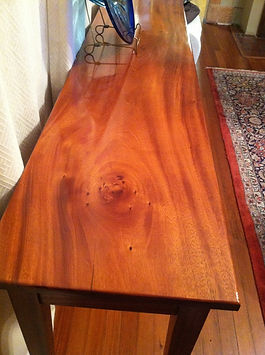
A Parson's table made for Lindsey. The table is solid mahogany with a one-piece top. Pinky hand-rubbed the finish.

Close-up of part of a cypress coffee table that Pinky made for his brother-in-law.



Pinky's interpretation of an antique sugar chest. It is made of Sapele, a cousin of mahogany that is imported from West Africa. Pinky enjoys the ribbon grain as it changes when viewed from different angles.

Some woods are recycled, like this Cypress table, which began life as a solid beam rescued from a demolition in the Warehouse District of New Orleans. Pinky split the beam down the center, leading to "book matching" of the center two boards and the outer boards. He then planed the entire top by hand the way it would have been done many years ago. Lindsey made the slip covers for recycled chairs.
Close-up of a section of an end table that Pinky made from a wood variously known as silky oak, lacey oak, and lacewood.

The "other" dining table. The family pet, Boogie, has a solid mahogany table for his food and water.
Sometimes artists and designers have commissioned Pinky to create furniture for them. Pinky was asked by artist Katie Rafferty, for example, to make a poplar bench to her specific size and design. She then painted these three characters from A Midsummer's Night Dream. The bench below was auctioned in 2003 to benefit the Louisiana Children's Museum.
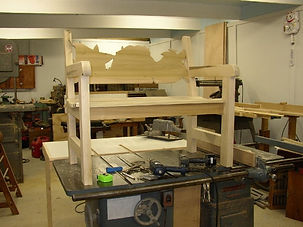
The bench in Pinky's workshop before painting.
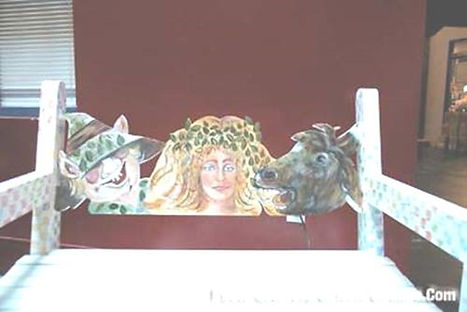
Pinky attended Newman from kindergarten through part of our senior year and then chose to move to Baton Rouge to live with a college friend of his father. He attended and graduated from Lee High School, currently ranked eighth in Louisiana, or in the top four percent of public high schools. From there he attended Nicholls State University in Thibodaux, Louisiana, southwest of New Orleans in Acadiana (French Louisiana).
The Nicholls campus was once part of the Acadia Plantation, and it fronts on Bayou Lafourche. Founded in 1948, the institution of Nicholls was originally part of LSU and became an independent part of the Louisiana State University system in 1956. Pinky graduated from Nicholls with BS and BA degrees, double majors in Management and Economics, and double minors in Finance and Accounting.
Pinky is the third generation member of his paternal family to work in the oil and gas industry of Louisiana. His paternal grandfather, born in the 1880s, was an accountant for Gulf Oil. Pinky learned the mechanics of oil drilling by going along to the wells with his father when he was a teenager. His first job after graduating from college was with Texaco. Much later in his career he did oil and gas exploration by putting together a 75,000 acre three-dimensional geophysical program across St. Bernard Parish, Louisiana. He is qualified in the courts of the State of Louisiana as an expert in Oil and Gas Contracts. His son is also employed in the oil and gas industry, and he is currently working in West Virginia.
Pinky's father, Charles "Pinky" Rohm, Jr., was an outstanding athlete in both football and track and field. In 1937 he was named the Most Valuable Player at LSU. At 5'8" and 145 pounds in high school, Pinky was not destined to follow in his father's athletic footsteps.
His mother, Shirley G. Rohm (1924-1981),was born and raised in New Orleans and worked as a corporate secretary in the medical field. She was also athletic and had considerable manual dexterity, enjoying piano, painting, and crocheting.

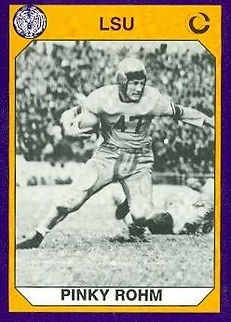
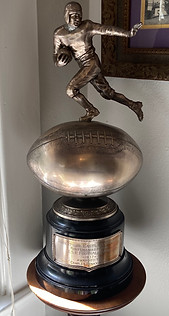
Pinky has not only made furniture from recycled wood, he has created pieces from recycled New Orleans iron fences and jewelry from recycled copper pipe and found objects. The table to the right has a glass top and iron fence pieces at each end. Below are examples of Pinky's jewelry creations, including cuffs, earrings, and pendants.

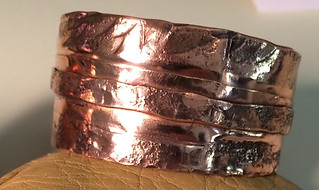
Copper bracelet hand hammered on an oak mandrel that Pinky turned on his lathe.
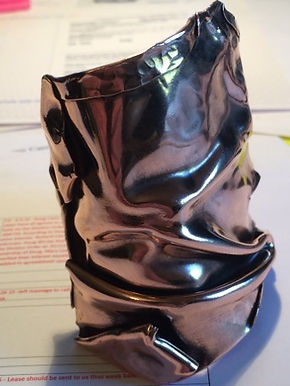.jpg)

Copper cuff with sandstone piece that Lindsey found and asked Pinky to use in jewelry.
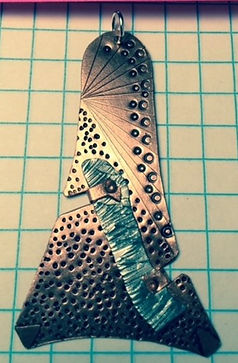
Two-inch long pendant with silver over copper.
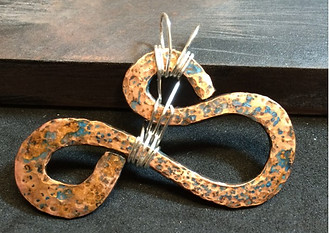
Copper cuff, handmade, polished, and lacquered. Made for Lindsey.
.jpg)
"Air-chased" copper cuff.
During the pandemic Pinky made copper bird feeders for presents for friends to help people slow down and watch the birds.

Ammonia fumed copper pendant with sterling silver wire bail.
.jpg)
Copper earrings.
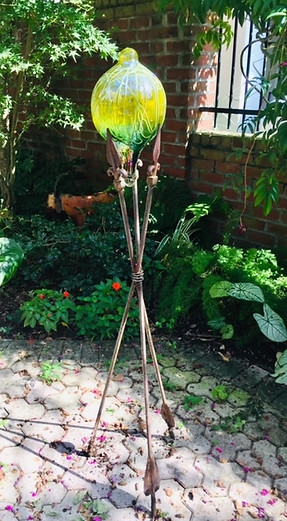
Backyard sculpture. The globe was a gift to Lindsey. Pinky made three arrows with spear heads on top and feathers on the bottom. The shafts are 1/2" steel rod, and it stands about five feet tall.
One of the commissions that interested me the most was a series of four interior burglar bars. The client wanted one set to resemble rain, one to include Fleur de lis, one to feature plants, and one to be an abstract design of Pinky's choosing. These designs intrigued me for several reasons. New Orleans is known for its crime rate, and burglar bars are usually an unattractive response to the threat of crime. The idea of making interior burglar bars that incorporate features of life in Louisiana struck me as a very creative collaboration between artist and client: lots of rain in New Orleans, the Fleur de lis from Louisiana's French heritage, and the edible cattails of Louisiana's swamps. The bars were made of 1/4 inch steel round rod and other metal formed by hand or hammered on Pinky's anvil and welded together. You can see the designs below.

Burglar bars as rain.
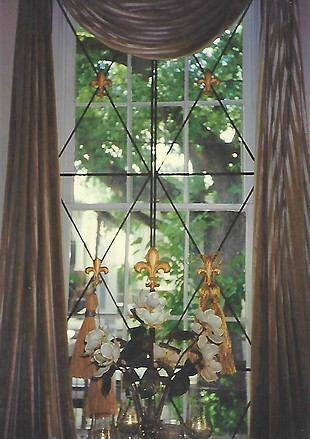
Incorporating Fleur de lis.
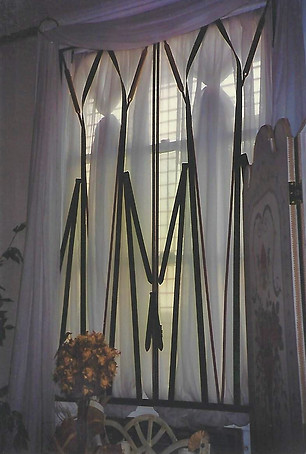
Burglar bars as cattails, a common Louisiana swamp plant. Also edible.

Abstract burglar bars.
Pinky started drawing after college. This is one of his drawings that he refers to as "doodles." He would do these in the evening after work while bonding with his two young stepdaughters. I noticed the detail and the complex three dimensionality of the drawing.
![IMG_2690[2352].jpg](https://static.wixstatic.com/media/da03de_254958acc2e24866bfb8bde83e13b3a3~mv2.jpg/v1/crop/x_423,y_209,w_3053,h_2480/fill/w_584,h_474,al_c,q_80,usm_0.66_1.00_0.01,enc_avif,quality_auto/IMG_2690%5B2352%5D.jpg)
Pinky is yet another gifted visual-spatial individual from the Newman class of 1967. He lives in a three-dimensional world where he designs, restores, and creates. Using his hands gives him joy. One theme of this website is the unusual number of people in our class who are talented in visual-spatial fields, and several classmates have reflected on how the mechanical drawing class influenced them professionally. Pinky said that "the course gave me another way to look at things."
He liked the class because it involved exact measurements and finite rules. He enjoyed the precision involved. Plus, he loved that the class was manual, and back then there was no CAD and there were no computers. He still uses graph paper, both at his desk and in his workshop. He also carries around a 6 X 9 spiral notebook for taking notes or making sketches, and he always has several grid papers in the book. Looking back, he has positive feelings about his education at Newman.